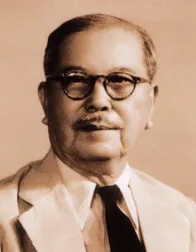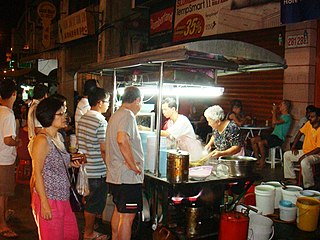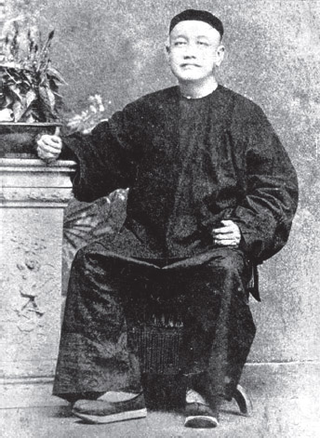Related Research Articles

Tan Kah Kee was a Chinese businessman, investor, and philanthropist active in Singapore and the Chinese cities of Hong Kong, Shanghai, Xiamen, and Guangzhou.

Siong Lim Temple, also known as Lian Shan Shuang Lin Monastery, is a Buddhist monastery located in Toa Payoh, Singapore, next to the Pan Island Expressway. The temple was founded in 1898, but the construction of the premises only began in 1902 by Low Kim Pong and was completed in 1907. The monastery was gazetted as a national monument in 1980 and subsequently underwent a decade-long restoration that began in 1991. The temple now boasts a seven storey gold-topped pagoda which is a replica of the 800-year-old Shanfeng temple pagoda in Fujian. The temple also consist of a columbarium for Qing Ming Festival visit.

Haw Par Corporation Limited is a Singaporean company involved in healthcare, leisure products, property and investment. It is the company responsible for Tiger Balm branded liniment (ointment). Its brands also included Kwan Loong and it also owns and operates weekend and leisure time destinations such as oceanariums.
The Ho Hong Bank (1917–1932) was a Malayan bank, established to provide banking services that, until 1912, were solely delivered by European banks. The bank was founded in 1917 and in 1932 merged with two other banks in Singapore to form the Oversea-Chinese Banking Corporation.
Nanyang Siang Pau was a newspaper in Singapore that was founded by philanthropist-entrepreneur Tan Kah Kee on 6 September 1923. It had a circulation across the Straits Settlement.

Tan Kim Seng, was a prominent Straits-born Chinese merchant and philanthropist in Singapore in the 19th century.
Sir Song Ong Siang was a lawyer and active citizen of the British Crown Colony of the Straits Settlements. He was an ethnic Hokkien as well as a third generation Hokkien Peranakan Baba Chinese with ancestry from Zhangzhou in Minnan region, and the first ever Asian in Singapore to be knighted. Song was noted for his contributions to the development of the Singapore civil society, and was held in esteem throughout the Colony.

Kapitan China Lim Ah Siang, a timber merchant and steam saw miller, the founder of "Chop Sin Moh" Johor Bahru, was the third leader of the Ngee Heng Kongsi of Johor, a legitimised secret society based in Johor Bahru. He was appointed to the position not because he was the most prominent Chinese in Johor at the time but rather, because he was not.

Song Hoot Kiam was a Singaporean community leader.

Lat Pau was one of the earliest Chinese-language newspapers published in Singapore. It was first published in December 1881 by See Ewe Lay under Lat Pau Press Ltd. It was published for 52 years, ending in March 1932. It was it the longest-running local-run Chinese newspaper before World War II.

Penangite Chinese are ethnic Chinese Malaysians of full or partial Chinese ancestry who either hail from or live within the State of Penang. As of 2020, 45% of Penang's population belonged to the Chinese ethnic group, making ethnic Chinese the largest ethnic community within the state.

Cheang Hong Lim JP was a Chinese opium merchant and philanthropist in Singapore. He was recognised by the British colonial administration as head of the local Hokkien Chinese community.
The Chinese Commercial Bank was a Malayan bank established in Singapore in 1912. It was also the first Hokkien bank in Singapore. In 1932, the bank was merged with Ho Hong Bank and Oversea-Chinese Bank to form the Oversea-Chinese Banking Corporation.
See Hoot Kee, alternatively spelled See Hoot Keh, See Hood Kee or Si Hoo Keh, was a prominent leader and pioneer in the Hokkien community in Singapore.
Chong Shing Yit Pao, was a Chinese-language newspaper in Singapore. The newspaper was founded in 1907 by Tongmenghui members in response to the growing influence of The Union Times, a paper which they had founded but had fallen under the control of reformists.
Yeh Chih Yun, also known as Ye Mao Bin, Ye Ji Yin, Yong Wen, Ting Song Lu Shi Sun and Xing Er Sheng, was a Chinese newspaperman and poet. He was the Chief Editor of Lat Pau, the first major Chinese newspaper in Singapore.
Lee Cheng Yan was a merchant, philanthropist, and leader of the Chinese community of Singapore.
The Kwong Yik Banking Corporation Limited, or simply the Kwong Yik Bank of Singapore was the first local bank established in Singapore and British Malaya. The Kwong Yik Bank was founded in 1903 by Cantonese businessmen led by Wong Ah Fook, to provide personal banking services and arrange mortgages and loans to its predominantly Chinese clientele.
References
- 1 2 3 Song, Ong Siang (1923). One Hundred Years' History of the Chinese in Singapore. J. Murray. p. 104.
- 1 2 3 Chong, Guang Kwa; Bak, Lim Kua (2019). A General History Of The Chinese In Singapore. World Scientific. pp. 390–391. ISBN 9813277653.
- 1 2 3 "See Ewe Lay". Reference@NLB. Singapore: National Library Board . Retrieved 18 June 2022.
- 1 2 Leong, Weng Kam (30 May 2016). "Exhibition shows early days of Chinese newspapers here". The Straits Times . Singapore.
- ↑ ""LAT PAU" EDITOR DEAD". Eastern Daily Mail and Straits Morning Advertiser. Singapore. 30 August 1906. Retrieved 18 June 2022.
- ↑ "DEATH OF A CHINESE EDITOR". The Straits Budget. Singapore. 30 August 1906. Retrieved 18 June 2022.